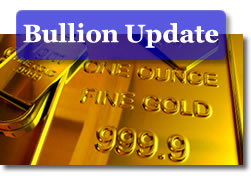 Honey, We Shrunk…The Hedge Books!
Honey, We Shrunk…The Hedge Books!
Good Day,
Bullion prices climbed towards $1115 overnight as overseas market participants helped gold recover from its two-week lows on the back of some bargain hunting in the low $1100’s and the continuing favourable nod it is receiving from various quarters worried about the impact of credit woes on certain currencies.
Positioning ahead of the US Fed meeting also played a role in gold’s comeback from its worst slide in seven weeks, as players are still leaning towards hearing from a ‘stand pat’ Fed this week.
The US dollar dipped back down to 80 on the trade-weighted index before the aforementioned meeting, as players expect no rate action from the American central bank for the moment. They are, however, still wary of further upside surprises in the greenback as the debate (outside as well as inside the Fed) as to when and in what manner the signals that no-cost money is an era whose time expired will become reality.
Fourteen month of zero-cost money have engendered commodities (and a few other assets) carry-trade parties such as the world has rarely seen before. Each Fed meeting now brings closer the prospect that the ‘carriers’ will have their favourite drug supply cut off from them by a Fed cognizant of the risks of leaving the spigots on for much longer. Still, the Fed sees virtually no inflation at the present time and some within the institution are actually worried about rates of inflation that are ‘too low’ –a fear that recalls the ‘unwelcome, substantial fall in inflation’ warning they issued back in 2003.
Businesses recently decimated by the economic contraction are now grabbing for market share any time they are offered an opportunity to produce things and are cutting prices in an effort to secure said share. Such strategies can engender the dreaded deflationary spiral that Ben Bernanke has been pedaling so hard to avoid. A delicate time, this. Still, some economists do not see the Fed acting to swing open the exit door until late 2010 up to mid-2011 at this time.
New York spot bullion dealing opened mixed this morning. Gold was ahead by $4.10 per ounce at 8:20 this morning, quoted at $1112.90 while silver advanced 12 cents to start at $17.24 the ounce. Resistance in gold remains around the $1120 area while the next higher target and resistance is found near the $1145 level.
Platinum dropped $4 to $1617.00 and palladium fell $1 to $461.00 per troy ounce. All was quiet on the rhodium front, where the metal continued at $2400.00 spot bid per ounce. Well, at least initially. The noble metal fell $10 to $2390 shortly after the market’s open. Looking at another one of the noble white metals, Bloomberg notes that: "an ounce of platinum bought 1.4642 ounces of gold late yesterday, the most in 18 months. The ratio averaged 1.24 last year and soared to 2.38 in May 2008, the highest level since 2001."
"Fundamentally, platinum looks better than gold," said Steven Zhu, head trader at Shanghai Tonglian Futures Co. "When the economy recovers, auto demand recovers. The launch of new exchange-traded funds linked to platinum has also greatly increased investment demand."
"New car registrations in the European Union rose 3 percent in February to 974,346 vehicles, the Brussels-based European Automobile Manufacturers’ Association said in a statement today. Platinum and palladium are mainly used in automotive pollution- control gear and jewelry." — observed Bloomberg.
Crude oil was on the cusp of the $80 per barrel mark with black gold traders also apparently waiting for fresh news to move the market. Marketwatch reported US stock futures a ‘creeping higher’ ahead of what it labeled as "what could be the final time that the Federal Reserve promises to keep interest rates at low levels for an “extended period” of time.
Meanwhile, Moody’s rating agency issued a warning to the world about the need to cut spending and rein deficits in, or risk losing the coveted AAA credentials currently still being enjoyed by some nations. The alarm bell was rung by Moody’s following its assessment that deficits in the US, Germany, the UK, and France are at the limits of what the agency feels comfortable with, before it starts removing the letter "A" from the alphabet soup marquis.
The greenback, however, rose after the cautionary report was issued yesterday as the Washington Post –which reported the Moody’s alert — said that the gain served as a reminder that the US currency remains the reserve currency of the world. Over in Europe, officials appear to have cobbled together a strategy for making certain "emergency loans" should Greece’s tax hike/ wage cut plans backfire and stall. The euro got a mild lift from the news, and was last seen at 1.371 against the US dollar. EU finance ministers will be meeting in Brussels today to discuss… more assistance plans for Greece.
In recent days we observed that our cautionary approach about several important gold market topics is now being echoed by other sources as well. Yesterday, we talked about the potential impact of ETF gold sales. Last week, the subject of Chinese central bank (lack of) gold buying desire was reinforced… by China. Now, one additional aspect of the gold market that these columns have warned about over the past year or so has also been identified by other market watchers as being potentially very impactful as we go forward.
We have on several occasions, brought you reports from Fortis Bank and others, reports that were warning that one of the major supportive (of price) factors in the gold market was/is about to expire and that its departure from the scene will remove one additional source of offtake whilst leaving supplies searching for willing takers.
The X factor? Mine de-hedging. It’s practically over. While GFMS currently cannot identify any clear-cut signs that hedging is taking place just yet, Marketwatch finds that: "Gold producers have been getting rid of their hedges as they seek more benefit from rising bullion prices. That means the pace for ridding these hedges will eventually have to ebb, which is bad news for gold prices, a new report [by the very same GFMS] says.
"This is another huge change in the gold market," says Patrick Kerr, managing director of Amerifutures Commodities and Options. When a gold producer unwinds a contract that agrees to sell gold at a point in future, it’s called de-hedging. The process usually supports gold prices since the act reduces the supply of gold created by these future contracts.
A new report prepared by metal consultants GFMS along with Societe Generale showed that 254 metric tons of gold were de-hedged in 2009. There’s only 236 metric tons left in the hedge book, [in other words, it looks like this]:

meaning that gold producers will have fewer contracts to unload next year. Barrick Gold Corp. unloaded the most hedges in 2009, with 165 tons. AngloGold Ashanti Ltd. is now the largest gold hedge-book holder, but the report predicts the company will be "the main player" to cut its hedges this year."
Good Day.
Jon Nadler
Senior Analyst
Kitco Metals Inc.
North America
Blog: http://www.kitco.com/ind/index.html#nadler
Check out other site market resources at Live Gold Spots, US Silver Coin Melt Calculator and American Silver Eagles.










